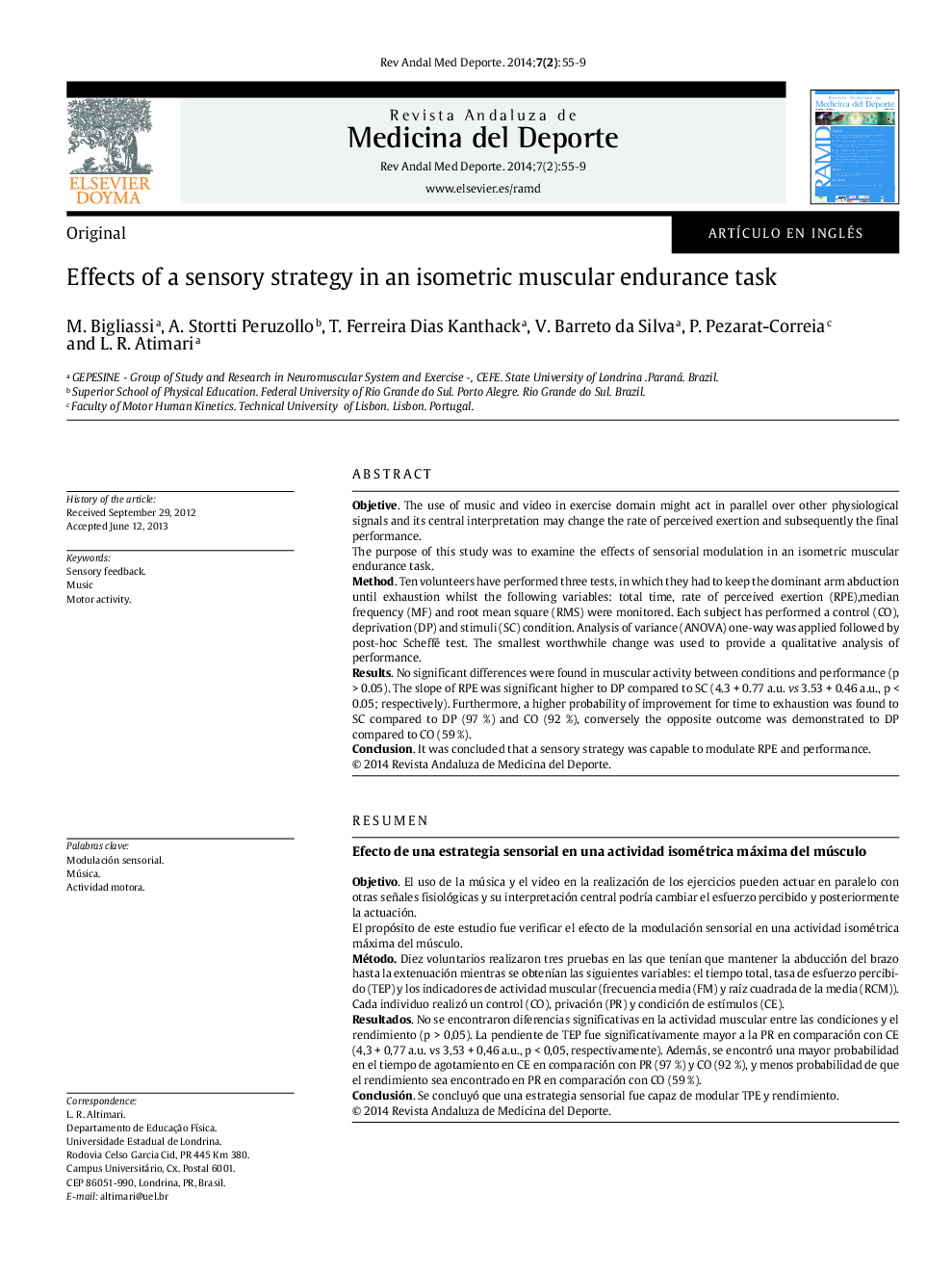| کد مقاله | کد نشریه | سال انتشار | مقاله انگلیسی | نسخه تمام متن |
|---|---|---|---|---|
| 4085731 | 1267896 | 2014 | 5 صفحه PDF | دانلود رایگان |
ObjetiveThe use of music and video in exercise domain might act in parallel over other physiological signals and its central interpretation may change the rate of perceived exertion and subsequently the final performance.The purpose of this study was to examine the effects of sensorial modulation in an isometric muscular endurance task.MethodTen volunteers have performed three tests, in which they had to keep the dominant arm abduction until exhaustion whilst the following variables: total time, rate of perceived exertion (RPE),median frequency (MF) and root mean square (RMS) were monitored. Each subject has performed a control (CO), deprivation (DP) and stimuli (SC) condition. Analysis of variance (ANOVA) one-way was applied followed by post-hoc Scheffé test. The smallest worthwhile change was used to provide a qualitative analysis of performance.ResultsNo significant differences were found in muscular activity between conditions and performance (p > 0.05). The slope of RPE was significant higher to DP compared to SC (4.3 + 0.77 a.u. vs 3.53 + 0.46 a.u., p < 0.05; respectively). Furthermore, a higher probability of improvement for time to exhaustion was found to SC compared to DP (97 %) and CO (92 %), conversely the opposite outcome was demonstrated to DP compared to CO (59 %).ConclusionIt was concluded that a sensory strategy was capable to modulate RPE and performance.
ResumenObjetivoEl uso de la música y el video en la realización de los ejercicios pueden actuar en paralelo con otras señales fisiológicas y su interpretación central podría cambiar el esfuerzo percibido y posteriormente la actuación.El propósito de este estudio fue verificar el efecto de la modulación sensorial en una actividad isométrica máxima del músculo.MétodoDiez voluntarios realizaron tres pruebas en las que tenían que mantener la abducción del brazo hasta la extenuación mientras se obtenían las siguientes variables: el tiempo total, tasa de esfuerzo percibido (TEP) y los indicadores de actividad muscular (frecuencia media (FM) y raíz cuadrada de la media (RCM)). Cada individuo realizó un control (CO), privación (PR) y condición de estímulos (CE).ResultadosNo se encontraron diferencias significativas en la actividad muscular entre las condiciones y el rendimiento (p > 0,05). La pendiente de TEP fue significativamente mayor a la PR en comparación con CE (4,3 + 0,77 a.u. vs 3,53 + 0,46 a.u., p < 0,05, respectivamente). Además, se encontró una mayor probabilidad en el tiempo de agotamiento en CE en comparación con PR (97 %) y CO (92 %), y menos probabilidad de que el rendimiento sea encontrado en PR en comparación con CO (59 %).ConclusiónSe concluyó que una estrategia sensorial fue capaz de modular TPE y rendimiento.
Journal: Revista Andaluza de Medicina del Deporte - Volume 7, Issue 2, June 2014, Pages 55-59
